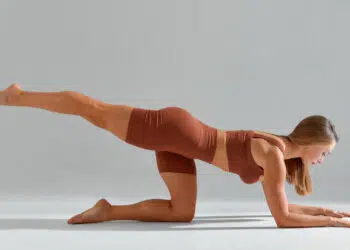While it’s true that squats, lunges, and hip thrusts are the trinity of ass-building greatness, you’ll get the best results for your toosh by including monster walks in your rotation. While the name may bring back unwanted childhood memories of the terrifying creature in your closet, this is the perfect technique to wake up your sleepy gluteus medius muscles.
The gluteus medius is one of the three butt muscles sandwiched between the larger maximus and smaller minimus. They all have different functions on the hip joint and you need them to perform lower and upper body movements. But the medius is especially victim to too much time on our rear ends which weakens them and consequently affects the hips.
Check out our complete guide to monster walks where we’ve included exercise instructions, benefits, tips, variations and more.
Choosing the right resistance band
There are many resistance band variations on the market. However, you’ll need one specifically for monster walks like the Gymbandit mini bands. It’s a small loop-shaped band also known as booty bands, are the best option for this exercise because you can wrap them around your legs and they will provide you with good resistance.
How To Do Monster Walks
Monster walking isn’t as simple as a biceps curl, but you shouldn’t be intimidated by it. We’ve included an easy to understand explanation of this technique along with a video demonstration.
- Wrap a band around both legs on the lower thigh just above the knees and keep your legs far enough apart to create tension in the band.
- Descend into a quarter squat and bend slightly forward at the waist. Note: The quarter squat stance will fire up your gluteus medius and tensor fasciae latae.
- Tense your abs and take large normal forward making sure to maintain tension in the band/s.
- Now take small steps backward maintaining the same technique.
Note: If you feel pain or the movement becomes uncomfortable on your knees, hips or ankles, you may be using too much resistance or taking too large of steps.
Level Up Your Fitness: Join our 💪 strong community in Fitness Volt Newsletter. Get daily inspiration, expert-backed workouts, nutrition tips, the latest in strength sports, and the support you need to reach your goals. Subscribe for free!
Watch the included video below for a demonstration of monster walks.
Pro Tip: Use one band just above the knee then when you become better at monster walks, add a band around your ankles too.
Benefits
You might call monster walks a form of accessory training alongside your main workout movements because they’re not a conventional resistance exercise. But they certainly have their place like other accessory type activities. Here are the reasons you should be including monster walks.
Strengthen the gluteus medius
The muscles that make up your butt are a lot more important and powerful than most people likely think. In fact, did you know the gluteus maximus (the largest butt muscle) is the largest muscle in the human body?
The gluteus minimus doesn’t quite have the same level of responsibility but it does contribute to femur and hip movement.
But when we sit on our butts for too long, the gluteus medius beings to atrophy which causes the hips to get used to being in a shortened position. Well, you can see where this could cause an issue.
Reinforce proper lower body mechanics
Knees caving inward is a big no-no when it comes to lifting and participating in other physical activities. You simply don’t have good support which makes it dangerous and limits your potential. Monster walks are one of the best ways to reinforce keeping the knees out in proper lifting posture because bands want to pull the legs in toward each other.
Variations
Check out these variations that give you more options to maximize band training.
1. Monster walk squat
While you’re monster walking you might as well add in a squat for a more complete lower body workout that also includes the gluteus maximus (largest butt muscle), quads, and hamstring muscles.
Level Up Your Fitness: Join our 💪 strong community in Fitness Volt Newsletter. Get daily inspiration, expert-backed workouts, nutrition tips, the latest in strength sports, and the support you need to reach your goals. Subscribe for free!
To do it:
- Wrap a band around both legs on the lower thigh just above the knees.
- Stand with your feet about hip width apart or in your normal squat stance to create tension in the band.
- Step to the left with your left foot so that your stance is wider than shoulder width.
- Bring your right foot in toward your left foot to return to a hip width stance.
- Drop your butt straight down into a squat and stand back up.
- Repeat the sequence for the desired number of repetitions.
2. Multidirectional monster walks
One of the most common ways to mix up monster walks is to do it in all different directions – forward, backward, laterally and diagonally. Most movements that we do at the gym occur in the sagittal plane (forward and backward) like lunges, squats, sit ups, curls, etc.
Well, humans are capable of moving in various planes which means we need to train accordingly. This will help to prevent injuries and maximize your efforts by strengthening the potential weak areas that get less attention in a training regime.
To do it:
- Place the band around your lower thighs just above the knees.
- Descend into a quarter squat and hinge slightly forward at the hips.
- Walk forward to a preset distance.
- Then walk backwards to a preset distance.
- Take a few steps to the left.
- Take a few steps to the right.
- Take a step forward diagonally.
- Take a step forward diagonally in the opposite direction and repeat to a preset distance.
- Repeat diagonal steps backward alternating the left and right foot.
How To Include Monster Walks In Your Training Regime
You should treat monster walks like any isolation resistance exercise. When done safely with proper form, you can jack up the resistance to increase the difficulty and get better gains. But start small and feel out the movement to ensure you’re doing it right.
Sets and distance
As far as how many sets and reps or the distance, that will also depend on your training experience. However, we recommend performing monster walks for 10-15 yards in either direction.
This is a good number to aim for and then you can adjust it into your workouts. The more advanced you get the more resistance you can stack on or the farther you can set the target distance.
When to include monster walks
The when is also important but again, depends on how you structure your training.
- Warmup – Monster walks make for an excellent warmup because you can activate your glutes before lifting which should help you to feel the muscles working even better.
- Finisher – Deliver the finishing blow to your hip muscles by knocking out 2-4 sets of monster walks after your main training routine.
- Standalone – Working long hours on your butt? Wake up sleepy glutes with 3-5 sets of monster walks on a day separate from training sessions.
Muscles Involved
While the monster walk is a silly name for an exercise, make no mistake, it’s a powerful movement for the muscles in the lower body. Learn about their anatomy and function below.

Gluteus Medius – Glute medius is one of the three butt muscles. It’s sandwiched between the gluteus maximus (largest butt muscle) and gluteus minimus (smallest butt muscle). Medius is the primary hip abductor (moves the leg away from the center of the body) but it other roles include stabilizing the pelvis to keep the torso upright and internally rotating the thigh.
It’s important to keep the medius strong and healthy which means you should be performing monster walks and stretching this muscle on a weekly basis.
Tensor Fasciae Latae – Belonging to the gluteal or butt group of muscles, the tensor fascia latae (TFL) is a very small muscle in the thigh that contributes to hip flexion and adduction.
Soleus – Located underneath and below the larger gastrocnemius, soleus is a calf muscle of the lower leg of which both work together to plantarflex (point the toes down) the foot and ankle. They are also important for posture, and athletic movements. The calves play a secondary role in monster walks and are not the target muscle group. However, they will still be engaged.
Bottom Line
If your butt muscles have been asleep for too long from inactivity then the monster walk is the perfect way to wake them up. Not only is it a great way to strengthen those tooshie muscles but it’s a fun way to mix up your training and will benefit your structural health and progress. After all, the butt isn’t just for show, it does some important things too.
Interested in measuring your progress? Check out our strength standards for Sit Ups, Hip Thrust, Squat, and more.








